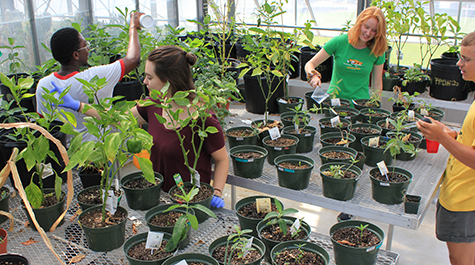Mite work: Greenhouse uses predatory insects for pest control
The William & Mary greenhouse has started a new program to limit the use of chemicals by relying on predatory insects for pest control. It’s the biological equivalent of fighting fire with fire — and so far it’s working.
The method is called biocontrol and according to Josh Puzey, assistant professor of biology at William & Mary, the university is one of the first in the region to implement the tactic as a way to reduce pesticide use and increase the overall biodiversity within the greenhouse.
“While biocontrol has been around for a while, with a rising concern of off-target effects of pesticides, there is an increasing need for organic methods to control pests,” Puzey said.
The idea first came about after Patty White Jackson, greenhouse manager and Puzey’s collaborator on the project, decided to reach out to faculty to see if they wanted try the method as a kind of ad-hoc experiment. Puzey had already done some reading on biocontrol and was eager to give it a shot.
“I’d been after professors for years saying we should do this and finally last year the biology department started supporting us,” Jackson said. “It seemed like an obvious thing to try. You don’t want to use poisons when you’re doing research with insects, and you don’t want to use poisons when you have students working here.”
Jackson and Puzey take their marching orders from Griffin Greenhouse Supplies, a 72-year-old Massachusetts-based horticultural supplier. The company provides the pests and consultation, while the biology department and a Green Fee grant provide the funding.
“I get tech support from Griffin. They tell me what I need and what to do and I do it,” Jackson said. “And no, it’s not the William & Mary Griffin, but it is a funny coincidence.”
The predatory insects arrive by the thousands, in red-capped tubes with labels that read more like superheroes than bugs, “Orius insidiosus, predator of thrips,” “Phytoseiulus persimilis, predator of spider mites” and “Amblyseius swirskii, predator of whitefly.”
“Isn’t that a great name?” Jackson said, holding a tube of 25,000 predatory mites. “Swirskii, swirskii. I catch myself saying it all the time.”
A team of students is in charge of administering the pests. They have to be careful about which plant gets which pest, Jackson explained. There is the potential for unintended casualties of both predator and prey.
“One of our thrip-eaters also eats caterpillars,” Jackson said. “When we were raising caterpillars in here, we couldn’t use the Orius insidiousus. We also have to take habitat into consideration for the insects we’re introducing. If we want to kill the thrips, their pupa live in the soil, so we need to add predatory nematodes into the soil. The nematodes are sensitive to UV light and heat, so that means we can only apply them late in the evenings.”
The single largest crop grown in the greenhouse is also one of the most vulnerable to pesticides, another incentive to eliminate chemical use, Puzey says. He and Harmony Dalgleish, assistant professor of biology, have spent years gathering specimens of milkweed from all over the country to study variation across its native range. There are roughly 50 different populations of milkweed within the greenhouse that cover most of eastern America.
“A lot of our experiments require that plants not be treated with pesticides,” Puzey said. “If we’re growing a milkweed plant and we need to grow a monarch butterfly caterpillar on it, the plant can’t have pesticide residue or else it’s going to kill the butterfly. We had to come up with a solution to manage the pests that was organic that wouldn’t affect the monarch butterfly.”
So far, at least when it comes to milkweed, biocontrol seems to be working. Hannah Call ’20 spent the summer working pest patrol at the greenhouse. Part of her job involves checking the milkweed for speckling — a sign of thrips, the small, slender insects with fringed wings that literally suck the life out of plants.
“They are very tiny, only about a millimeter long, and yellowish. And they are our enemies,” Call said. “They create these white patches on the plants because they suck out the contents of the plants’ cells, meaning they take out the chlorophyll and the cells turn white. You know you’re doing a good job when there are no white spots on the new growth at the top of the plants.”
A recent survey of dozens of milkweed plants yielded plenty of thrip-free new growth, a sign that the strategy is a success. Puzey says greenhouses are the ideal test sites for biocontrol, because they are isolated, designed to limit herbivorous insects. If an insect does get inside, there are no natural predators to control it, meaning it can multiply and quickly damage crops. Puzey adds that even industrial-sized greenhouses are looking toward adding more natural predators into the equation.
“Even though the ecological footprint of the William & Mary greenhouse is small, it can serve as a model for how it can be done on a bigger scale,” Puzey said. “This is a model for sustainable growing practices, a model for the future. It’s going to be a good teaching opportunity for the community, showing it’s possible to use natural controls as alternatives to pesticides.”

















